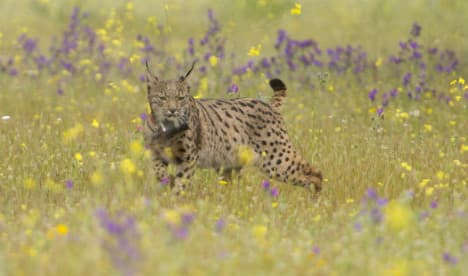DNA confirms endangered lynx has returned to Madrid after 40 years

Scientists are able to confirm that the world’s most endangered feline is making a comeback in the hills around Spain’s capital after an absence of four decades.
The return of the Iberian lynx (Lynx Pardinus) to the wooded hills of the Guadarrama valley has been confirmed by a team from Madrid’s Complutense University (UCM) thanks to DNA analysis of scat samples.
The presence of the felines in the Community of Madrid was suspected last spring after several sightings.
It was thought that a male lynx released late last year in Toledo province through a World Wildlife Fund captive breeding programme may have travelled into the Guadarrama valley region in search of new territory.
"By examining the reported sightings of lynx it was possible to draw up a likely map of its territory and then we went to work collecting samples," explained Germán Alonso Campos, an ecology professor at the UCM.
DNA tests determined that the faeces were those of lynx.
"We can’t say exactly how many but there are likely to be three or four individual animals," Alonso told Spain’s ABC newspaper, adding that the exact location of the lynx habitat would not be made public for their own protection.
"It is great news and it means now their presence in the Madrid region can be taken account of when assessing environmental impact of projects etc."
El lince se deja ver por el río Guadarrama en #Madrid (Foto EFE.Vía @abc_es) https://t.co/uWceh0qUEu pic.twitter.com/t99ZjuftIo
— TurismoMadrid (@TurismoMadrid) December 1, 2015
Spain has made enormous efforts to boost the wild population of the Iberian lynx, the smaller cousin of the Eurasian lynx, after it was almost wiped out by the end of last century.
Threats including illegal hunting, a loss of habitat and a disease that wiped out their natural prey of rabbits saw the population plummet to just 94 animals in just two small territorial pockets in Andalusia.
But progressive captive breeding programmes that saw creatures released into the wild and a concerted effort by authorities to protect their natural habitat has seen the numbers grow to 327 in the wild by the end of 2014.
In recognition of the huge efforts made, the Iberian lynx was downgraded from a 'critically endangered' species to 'endangered' on the International Union for the Conservation of Nature (IUCN) Red List when it was updated in July.
But one of the biggest threats to the lynx remains highways with 22 animals killed on the roads last year alone.
Comments
See Also
The return of the Iberian lynx (Lynx Pardinus) to the wooded hills of the Guadarrama valley has been confirmed by a team from Madrid’s Complutense University (UCM) thanks to DNA analysis of scat samples.
The presence of the felines in the Community of Madrid was suspected last spring after several sightings.
It was thought that a male lynx released late last year in Toledo province through a World Wildlife Fund captive breeding programme may have travelled into the Guadarrama valley region in search of new territory.
"By examining the reported sightings of lynx it was possible to draw up a likely map of its territory and then we went to work collecting samples," explained Germán Alonso Campos, an ecology professor at the UCM.
DNA tests determined that the faeces were those of lynx.
"We can’t say exactly how many but there are likely to be three or four individual animals," Alonso told Spain’s ABC newspaper, adding that the exact location of the lynx habitat would not be made public for their own protection.
"It is great news and it means now their presence in the Madrid region can be taken account of when assessing environmental impact of projects etc."
El lince se deja ver por el río Guadarrama en #Madrid (Foto EFE.Vía @abc_es) https://t.co/uWceh0qUEu pic.twitter.com/t99ZjuftIo
— TurismoMadrid (@TurismoMadrid) December 1, 2015
Spain has made enormous efforts to boost the wild population of the Iberian lynx, the smaller cousin of the Eurasian lynx, after it was almost wiped out by the end of last century.
Threats including illegal hunting, a loss of habitat and a disease that wiped out their natural prey of rabbits saw the population plummet to just 94 animals in just two small territorial pockets in Andalusia.
But progressive captive breeding programmes that saw creatures released into the wild and a concerted effort by authorities to protect their natural habitat has seen the numbers grow to 327 in the wild by the end of 2014.
In recognition of the huge efforts made, the Iberian lynx was downgraded from a 'critically endangered' species to 'endangered' on the International Union for the Conservation of Nature (IUCN) Red List when it was updated in July.
But one of the biggest threats to the lynx remains highways with 22 animals killed on the roads last year alone.
Join the conversation in our comments section below. Share your own views and experience and if you have a question or suggestion for our journalists then email us at [email protected].
Please keep comments civil, constructive and on topic – and make sure to read our terms of use before getting involved.
Please log in here to leave a comment.